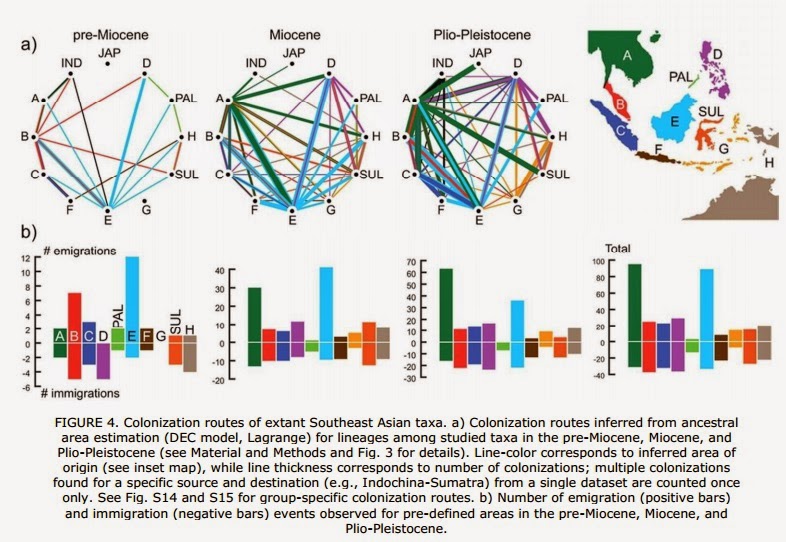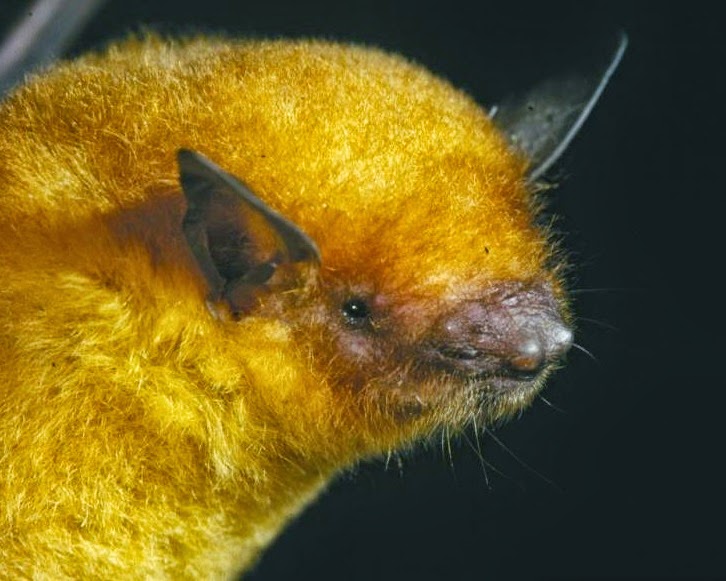[Most Recent Entries] [Calendar View]
Tuesday, August 5th, 2014
| Time | Event | ||
| 5:18a | [BioGeography • 2014] Borneo and Indochina are Major Evolutionary Hotspots for Southeast Asian Biodiversity Abstract Tropical Southeast Asia harbors extraordinary species richness and in its entirety comprises four of the Earth's 34 biodiversity hotspots. Here, we examine the assembly of the Southeast Asian biota through time and space. We conduct meta-analyses of geological, climatic and biological (including 61 phylogenetic) datasets to test which areas have been the sources of long-term biological diversity in SE Asia, particularly in the pre-Miocene, Miocene and Plio-Pleistocene, and whether the respective biota have been dominated by in situ diversification, immigration and/or emigration, or equilibrium dynamics. We identify Borneo and Indochina, in particular, as major ‘evolutionary hotspots’ for a diverse range of fauna and flora. While most of the region's biodiversity is a result of both the accumulation of immigrants and in situ diversification, within-area diversification and subsequent emigration have been the predominant signals characterizing Indochina and Borneo's biota since at least the early Miocene. In contrast, colonization events are comparatively rare from younger volcanically active emergent islands such as Java, which show increased levels of immigration events. Few dispersal events were observed across the major biogeographic barrier of Wallace's Line. Accelerated efforts to conserve Borneo's flora and fauna in particular, currently housing the highest levels of Southeast Asian plant and mammal species richness, are critically required. Key words: phylogenetics, biogeography, geology, palynology, climate change, ecology Mark de Bruyn, Björn Stelbrink, Robert J. Morley, Robert Hall, Gary R. Carvalho, Charles H. Cannon, Gerrit van den Bergh, Erik Meijaard, Ian Metcalfe, Luigi Boitani, Luigi Maiorano, Robert Shoup and Thomas von Rintelen. 2014. Borneo and Indochina are Major Evolutionary Hotspots for Southeast Asian Biodiversity. Systematic Biology. DOI: dx.doi.org/10.1093/sysbio/syu047 | ||
| 4:58p | [Mammalogy • 2014] Myotis midastactus | Golden Myotis | Murciélago vespertino de oro • A New Species of Myotis (Chiroptera, Vespertilionidae) from northeastern Bolivia
Abstract We describe Myotis midastactus sp. nov. from the Bolivian savanna on the basis of differences in fur color, and cranial and external features that unquestionably distinguish it from all other Neotropical Myotis. This new species is morphologically allied to M. simus Thomas, 1901 and other species in the M. ruber group. Myotis midastactus is endemic to Bolivia, where it occurs with 6 congeners—albescens, dinellii, keaysi, nigricans, riparius, and oxyotus. Previously identified as M. simus, M. midastactus is in syntopy with M. nigricans and M. riparius in the department of Santa Cruz, and there is no evidence that true M. simus occurs in Bolivia. Key words: Myotinae, Myotis simus, Myotis ruber group, Neotropics, South America Holotype.— Adult male, AMNH 211156, with skin, complete skull, and postcranial skeleton (Figs. 1 and 2), collected by S. Anderson (field number SA 5871), on 9 September 1965. External and craniodental measurements for the type series are in Table 1. Type locality.— Cercado, Río Mamoré, Beni, Bolivia, about ´23 km W of San Javier (148340 S, 648550 W). Distribution.— Myotis midastactus is known only from Bolivia, with all records from the departments of El Beni and Santa Cruz Etymology.— The name M. midastactus is an allusion to the legend of Midas, the mythical Greek king whose touch turned everything to gold. It is a Latinized word (Gr. Μίδας, Midas; L. tactus, touch) in apposition to Myotis, and literally means Midas touch in reference to the golden-yellow fur, which is unique among New World Myotis. We suggest the English vernacular name Golden Myotis, and the Spanish vernacular, murciélago vespertino de oro. Moratelli, Ricardo & Wilson, Don E. 2014. A New Species of Myotis (Chiroptera, Vespertilionidae) from Bolivia. Journal of Mammalogy. 95 (4): E17–E25. doi: 10.1644/14-MAMM-149 Ricardo Moratelli. 2012. Myotis simus (Chiroptera: Vespertilionidae). Mammalian Species. 44(1); 26-32. doi: http://dx.doi.org/10.1644/892.1 Bolivian golden bat revealed as 'new species' http://www.bbc.co.uk/nature/28583377 Bat conservation in threatened ecosystems of Bolivia Aguirre, L.F., A. Vargas & S. Solari. 2009. Clave de campo para la identificación de los murciélagos de Bolivia. Centro de Estudios en Biología Teórica y Aplicada. Cochabamba, Bolivia. 38 pp [Key for Bolivian Bats] Myotis midastactus is the fifth new species of bat Dr Moratelli has described. Others include Myotis diminutus, a tiny bat species found in the Ecuadorian Andes; Myotis lavali from north-eastern Brazil, Myotis izecksohni found in Atlantic forest in southern Brazil, and Myotis handleyi from the mountains of northern Venezuela. Ricardo Moratellia and Don E. Wilsonb. 2011. A new species of Myotis Kaup, 1829 (Chiroptera, Vespertilionidae) from Ecuador. Mammalian Biology - Zeitschrift für Säugetierkunde. 76(5); 608–614. DOI: dx.doi.org/10.1016/j.mambio.2010.10.003 | http://news.mongabay.com/2010/1116-hance | ||
| 5:48p | [Ichthyology • 2012] Serrapinnus sterbai • Description of a new characins (Characiformes: Characidae: Cheirodontinae) from the eastern parts of Brazil with comments on S. gracilis (Géry, 1960) comb. nov. and S. littoris (Géry, 1960) comb. nov.
Abstract Serrapinnus sterbai spec. nov. from the eastern parts of Brazil (probably Araguaya drainage) is described. Typically there are (1) a black longitudinal band from the eye to the basis of caudal-fin, (2) an incomplete lateral line with eight to 12 pored scales, (3) 32 to 34 scales in a longitudinal line, (4) 21 to 23 anal-fin rays (total), (5) 32 to 33 vertebrae (4+9–10+18 – 20), (6) 14 to 16 gill-rakers on the first left arch (5 – 6 /9–10), (7) five seven- to ninecuspid premaxillary teeth, (8) two to three sevencuspid maxillary teeth, (9) five sevencuspid mandibulary teeth, (10) head relatively small (3,93 to 4,71 times in SL) and (11) body depth moderately high (2,63 to 3,18 times in SL). The species is easy to identify from all other members of the genus by its coloration. Cheirodon gracilis Géry, 1960 and Cheirodon littoris Géry, 1960 are transferred into the genus Serrapinnus. Key words: Teleostei, Characiformes, Serrapinnus, new species, Brazil, South America. Zarske, A. 2012. Serrapinnus sterbai spec. nov. – Beschreibung eines neuen Salmlers (Teleostei: Characiformes: Characidae: Cheirodontinae) aus Brasilien mit Bemerkungen zu S. gracilis (Géry, 1960) comb. nov. und S. littoris (Géry, 1960) comb. nov. Vertebrate Zoology. 62 (1): 3–17. Serrapinnus sterbai spec. nov. – Description of a new characins (Teleostei: Characiformes: Characidae: Cheirodontinae) from Brazil with comments on S. gracilis (Géry, 1960) comb. nov. and S. littoris (Géry, 1960) comb. nov. |
| << Previous Day |
2014/08/05 [Calendar] |
Next Day >> |




